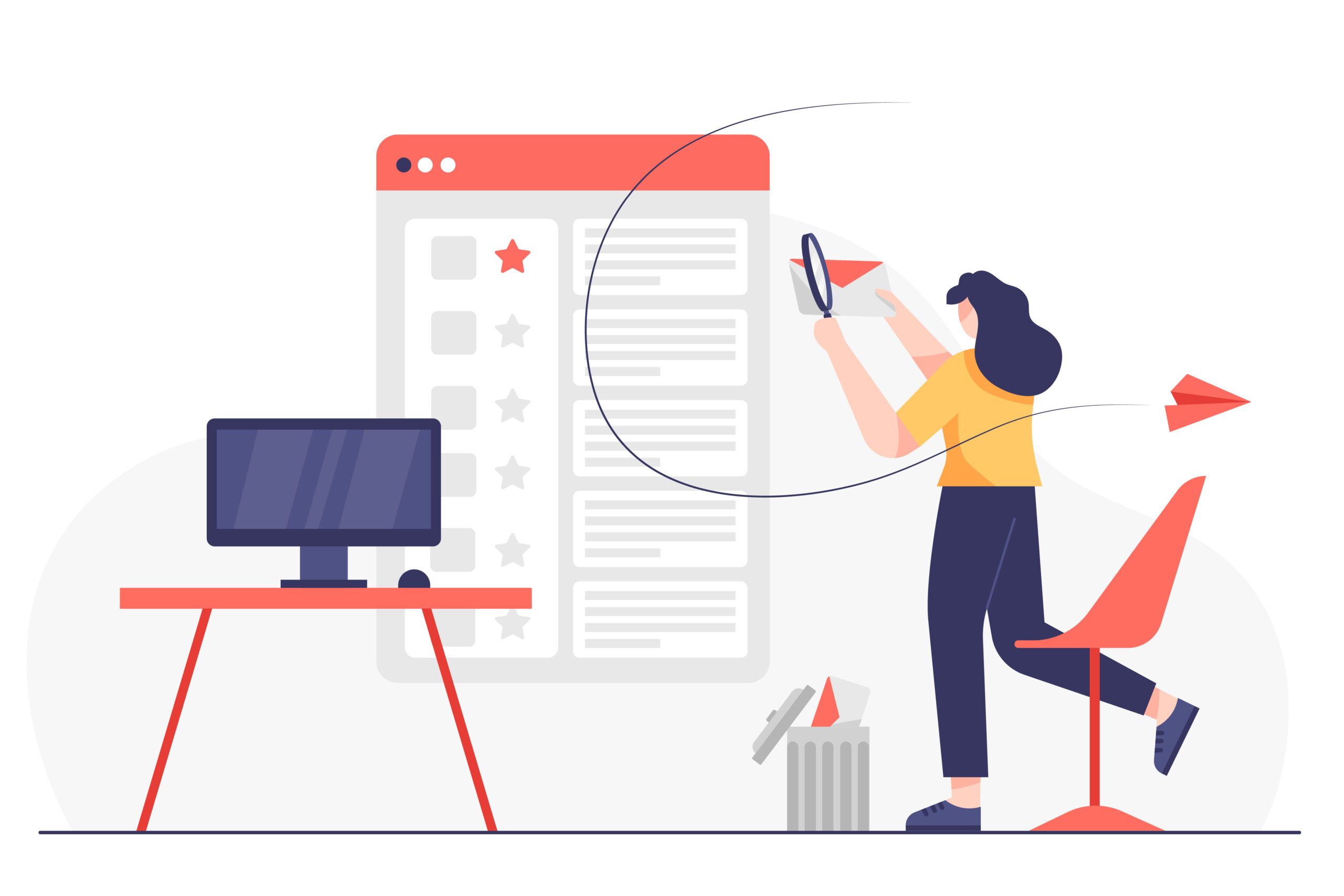Survey Monkey has earned quite a name for itself in the digital marketing space for a lot of good reasons....

How Customer Feedback Loops Help Your Business Thrive
Aside from you and your team, the people who know your brand best are your customers.
That said, your customers are the best sources of feedback if you want to improve your offerings and pinpoint areas where you might be lacking. Better yet, most customers are more than willing to share their thoughts with you.
A customer feedback loop is the continuous process of collecting feedback, analyzing it, and implementing changes based on the insights you discover. But what does this process look like in real life?
In this guide, we’ll go over the stages of customer feedback loops, why they’re important, and how you can create an effective loop for your company.
What is a Customer Feedback Loop?
A customer feedback loop is basically how companies keep tabs on what their customers think about their products or services and make improvements based on that feedback.
It starts with gathering opinions through things like surveys, social media, and reviews. Then, you dig into this feedback to spot trends and figure out what’s working and what’s not. Based on these insights, you might tweak a product, improve a service, or make other changes.
After that, you can reach out to the customers who gave feedback to let them know what’s been done—this shows they’re actually listening and care about what their customers have to say. Finally, you can watch how these changes play out to make sure they’re really solving the issues. This feedback loop helps businesses stay connected with their customers’ needs and keep improving over time.
Why You Need a Customer Feedback Loop
A well-established customer feedback loop is a must-have if you want your business to succeed in today’s market and surpass your competitors. Here are several ways customer feedback loops can help your business thrive:
Gathering Feedback For Product Teams
A well-established customer feedback loop is a must for keeping a product team on track and helping them make all sorts of improvements. Here’s why it matters:
- Understanding the customer journey: When teams get feedback, they really see the product through their customers’ eyes. This can highlight where customers are having a tough time and where they’re loving the experience, which can help the team smooth out the rough patches and double down on what’s working.
- Segmentation strategy: Feedback also reveals different kinds of customers and what each group really cares about. Some might want more features, while others might value simplicity. This lets the team tailor the product more precisely to make sure they’re hitting the right notes for each group.
- Quality assurance: Customers often point out what’s wrong or could be better, which is invaluable data for quality assurance. This helps the team fix bugs or tweak things to improve quality and keep users happy.
- Innovation opportunities: Sometimes, customers come up with ideas for new features or even new products. These suggestions can lead to real innovations that set the product apart and meet customers’ needs even better.
Gathering Feedback For Customer Service Teams
Gathering feedback is incredibly valuable for customer service teams because it helps them see where they’re knocking it out of the park and where they need to up their game. Here’s a breakdown of why it’s so important:
- Identifying customer pain points: Understanding exactly where customers are running into trouble can revolutionize your customer service strategies. When customers highlight these problems, the customer service team can work to clarify, fix, or improve these aspects.
- Improving response time: Feedback often includes how customers feel about the time it takes to get their issues resolved. If there’s a trend of customers mentioning slow responses, it’s a clear signal that the team needs to find ways to speed things up.
- Maximizing customer retention: The way a company handles customer service can make or break its relationship with customers. When service teams listen to feedback and act on it, they show customers that their concerns are taken seriously. This can turn a potentially negative experience into a positive one, encouraging loyalty.
Gathering Feedback For Sales Teams
The sales team is responsible for driving revenue and growing the business, which is why a customer feedback loop is a non-negotiable to maximize their operations. Gathering feedback helps them stay sharp and adapt to what their customers really want. Here’s how feedback makes a big difference:
- Discovering new opportunities: Sometimes, customer feedback can point out needs or wants that haven’t been addressed yet. By listening to what customers are saying, the sales team can discover these new opportunities and potentially increase their sales and expand their market.
- Creating new strategies: The insights from customer feedback can tell the sales team what’s working and what’s not, from the way they communicate to the kind of follow-ups they do. For example, if customers like a more personal touch or need more detailed product information early on, the team can adjust their approach to meet these preferences.
- Collecting insights into competitive positioning: Feedback often includes how customers see the company compared to the competition. This can guide them to highlight certain features more, adjust pricing, or even suggest improvements to stay ahead.
Maximizing Your Revenue and Profitability
A functional customer feedback loop can help you increase your business’s revenue and profitability in a number of ways. Regularly collecting feedback and acting on it can help you quickly sort out any issues. This customer feedback strategy reduces the hassle of dealing with returns and complaints and generally keeps customers happier.
Plus, when customers see that you’re actually listening and making changes based on their feedback, they’re more likely to stick around. It’s way cheaper to keep existing customers happy than to always be chasing new ones. And if they’re really satisfied, they’ll probably buy more from you and even tell their friends about your business, which means more sales without spending extra on marketing.
4 Stages of a Customer Feedback Loop
The average customer feedback loop includes five key stages. Let’s go over them one by one.
Step 1: Gather Customer Feedback
The “collection” part of a customer feedback loop is all about gathering as much input as you can from your customers. You want to pull in feedback from a bunch of different places like online surveys, social media comments, direct emails, and even conversations that happen during customer support calls.
The more feedback you collect, the clearer the picture you’ll get about what your customers love, what frustrates them, and what they think could be better.
You can collect feedback in a lot of ways. Some of the best customer feedback tools include:
- Surveys: One of the most common methods, surveys can be sent via email, presented on websites, or even conducted in person. They can include multiple-choice questions, Likert scales, or open-ended questions to gather quantitative and qualitative data.
- Interviews: Conducting one-on-one interviews, either in person, over the phone, or through video calls, allows for deeper insights into customer experiences and opinions. This method is particularly valuable for detailed explorations of customer satisfaction.
- Focus groups: Bringing together a group of customers to discuss their experiences with your product or service can provide rich qualitative data and insights into customer needs and preferences.
- Feedback forms: Embedded on your website or app, feedback forms are an easy way for customers to leave feedback at their convenience. These forms can be tailored to specific aspects of the user experience you want to explore.
- Social media: Monitoring social media platforms where customers may spontaneously share their opinions and experiences can provide real-time feedback. Engaging with customers on these platforms can also encourage more feedback.
- User activity data: Analyzing how customers interact with your website or product can indirectly provide feedback. Metrics like usage frequency, session duration, and feature usage can highlight areas that are either appealing or problematic.
- Net Promoter Score (NPS): NPS surveys ask customers to rate the likelihood that they would recommend your product or service to others. NPS can be a strong indicator of customer satisfaction and loyalty.
- Customer support interactions: Feedback can also be collected during support calls or chats. Customers often share their grievances and suggestions during these interactions.
- Transactional emails: Follow-up emails after a purchase or interaction asking for feedback on the experience can be an effective method to gather timely, relevant customer feedback data.
- Customer Effort Score (CES): This metric is used to evaluate how easy it is for customers to interact with a company, typically after a service interaction. CES helps businesses understand how much effort customers need to exert to get their issues resolved, use a product, or complete a transaction.
Step 2: Analyze Customer Feedback
Start by organizing the feedback—sort it into categories like product issues, service experiences, or improvement suggestions. Don’t forget about negative feedback!
If you’ve got numbers, like ratings or Net Promoter Scores, crunch them to see overall trends or satisfaction levels. For text responses, like comments or open-ended survey answers, look for common themes or repeated phrases that can clue you into broader sentiments or issues.
It’s also useful to track these trends over time to see if things are getting better or if new problems are popping up. Comparing your current feedback with past data or industry benchmarks can show you how well you’re doing and what you need to focus on.
However, not every piece of feedback will need immediate action—figure out which issues are the most urgent or affect the most customers. The end goal here is to turn this analysis into a clear plan of action and decide on practical steps that can help improve your product or service based on what your customers are really saying.
Step 3: Implement Changes Based on Insights
After you collect customer feedback and extract actionable insights from your findings, it’s time to make improvements based on your data. Begin by creating detailed action plans that outline what needs to change, who’s going to handle it, and when it should be done.
Implementing changes could mean:
- Addressing product feature requests
- Revamping your customer service protocol
- Redesigning your website
- Tweaking your branding imagery or messaging
- Getting rid of annoying marketing messages
- Adding more services
It’s important to get everyone on board, so make sure to loop in the relevant teams—like engineering, marketing, or customer support—so they can lend their expertise. Since you can’t tackle everything at once, prioritize your actions based on how much they’ll impact customer satisfaction and what’s feasible with your resources.
Step 4: Close the Feedback Loop
Closing the customer feedback loop simply means letting your customers know about the changes you’ve made using their insights.
A simple update through email, social media, or on your website about the changes you’ve implemented can make all the difference. It’s also nice to throw in a thank you to show your appreciation for their help. If their feedback led to a big improvement or a new feature, why not share that story more widely?
Doing so highlights how customer opinions are shaping your business, which can encourage more feedback and show that you’re committed to continuous improvement. Keep inviting feedback, too, and make it clear that this is an ongoing conversation and their thoughts are always welcome.
Every now and then, it’s also smart to check in on how the whole feedback process is working—ask yourself if you’re really capturing the feedback you need and acting on it effectively. For those customers who gave particularly crucial feedback, a personal follow-up can further show that you’re attentive and committed to making sure they’re happy with the way things turned out.
Best Practices for Customer Feedback Loops
Establishing a successful customer feedback loop is sometimes easier said than done. So, we’ve observed some of the best businesses and found out a few best practices that they employ:
Encourage Honest Feedback
To really understand what your customers think, you need to make them feel comfortable being honest. This means setting up easy ways for them to give feedback, like online forms or quick surveys, and reassuring them that their responses are anonymous.
When customers know their feedback is taken seriously and used to make improvements, they’re more likely to open up and share their true feelings.
Gather Feedback From Different Channels
Not everyone likes to give feedback the same way. Some might prefer to fill out a survey, while others might want to chat on social media or even in person.
Offering various ways for customers to share their thoughts can help you hear from more people and get a broader perspective on what’s working and what isn’t.
Act Swiftly
After gathering customer feedback, especially if it’s about a problem, act on it quickly. This shows your customers that you’re really listening and care about fixing issues fast. Plus, addressing problems promptly can prevent them from getting bigger and hurting your relationship with your customers.
Segment Your Customers
Break down feedback by customer types, like new vs. long-term users to tailor your actions more closely to meet specific needs and issues that different groups might be facing. Here are a few examples of customer groups:
- First-time customers
- Customers who have been with your brand for more than six months, a year, or more
- Website visitors who dropped from your funnel
- Customers who bought from you only once
- Customers grouped by state, city, or country
- Customers grouped by age or gender
- Visitors who haven’t opened your emails
- Existing customers who haven’t purchased anything in a while
Make Your Life Easier with Automation
Using automation to manage customer feedback can make your job a lot easier and your responses quicker and more effective. With the help of AI and machine learning, you can sift through tons of feedback fast, spotting trends and themes that might otherwise take ages to find.
These technologies can sort feedback into categories like product issues or service complaints, and they can even pick up on the mood behind the messages—whether customers are happy, frustrated, or something in between.
Plus, analytics tools like FullSession can provide real-time insights, which is useful in today’s fast-paced markets where customer preferences can change quickly. Being able to react swiftly and smartly to what your customers are saying can really boost your product and service levels.
Incentivize Feedback
Sometimes customers need a little nudge to give feedback. Offering things like discounts, entry into a prize draw, or small gifts can encourage more people to share their thoughts. In turn, you can increase the amount and variety of feedback you get.
Plus, incentives can help improve customer loyalty and satisfaction.
Share What You Do With Customer Feedback
Sharing what you do with customer feedback revolves around being transparent and showing your customers that their voices are heard. When you openly discuss the feedback you’ve received and explain the steps you’re taking in response, it does wonders for trust.
A great way to do this is through regular updates in your newsletters or on a dedicated section of your website. This informs your customers about the improvements you’re making and publicly acknowledges the role their input plays in shaping your business.
This kind of openness can encourage more customers to provide feedback because they know that their suggestions could be featured and lead to real changes. It’s a powerful way to demonstrate your commitment to customer satisfaction and make your feedback loop a key part of your customer relationship strategy.
Customer Feedback Loop Example
Company: “Trendy Tech Gear,” an online retailer specializing in the latest technology accessories.
Step 1: Collection
Trendy Tech Gear regularly sends out post-purchase email surveys to customers asking them to rate their customer experience and the products they bought. They also monitor reviews on their product pages and keep an eye on social media mentions and comments.
Step 2: Analysis
After collecting a month’s worth of feedback, the team at Trendy Tech notices several reviews pointing out that the checkout process is confusing, particularly the payment options section.
Customers are also frequently mentioning on social media that they love the product range but wish there were more eco-friendly packaging options.
Step 3: Action
With this feedback in mind, the Trendy Tech team decides to:
- Redesign the checkout process to make payment steps clearer and more user-friendly. They introduce better labeling and a simplified layout.
- Switch to eco-friendly packaging for their products and highlight this change on their product pages and in marketing materials to align with their customers’ values.
Step 4: Follow-Up
Trendy Tech sends an email to customers who had provided the specific feedback about the checkout process and packaging, explaining the changes made. They also post updates on their website and social media channels detailing the new checkout interface and the switch to eco-friendly packaging, inviting further comments and suggestions.
Step 5: Monitoring
Over the following months, Trendy Tech closely monitors customer feedback on the new checkout process and the reception of the eco-friendly packaging. They use customer satisfaction surveys and track comments on social media and product reviews to gauge the impact of these changes.
Finally, sales data and repeat customer rates are also analyzed to assess the financial impact of the updates.
Dive Deeper into Customer Feedback With FullSession
Web analytics is your new best friend when it comes to establishing effective customer feedback loops. Lucky for you, you’re already in the right place.
FullSession is an analytics tool that deserves a spot in your business toolbelt. With a FullSesion plan, you can gain access to the following features:
- Session replays: Watch how users interact with your site to see exactly where they might be running into problems or getting frustrated.
- Heatmaps: Get a visual of where customers click the most and least. Heatmaps give you a clear picture of hot spots and dead zones on your pages.
- User behavior analytics: Dive into the data to understand user actions better and help you spot trends and areas that need attention.
- On-site polls and surveys: Directly collect feedback from your users right on your site, combining what they say with what they do.
FullSession Pricing Plans
The FullSession platform offers a 14-day free trial. It provides two paid plans—Basic and Business. Here are more details on each plan.
- The Basic plan costs $39/month and allows you to monitor up to 5,000 monthly sessions.
- The Business plan costs $149/month and helps you to track and analyze up to 25,000 monthly sessions.
- The Enterprise plan starts from 100,000 monthly sessions and has custom pricing.
If you need more information, you can get a demo.
Install Your First Website Feedback Form Right Now
It takes less than 5 minutes to set up your first website or app feedback form, with FullSession, and it’s completely free!
FAQs About Customer Feedback Loops
How do you collect customer feedback?
Collecting feedback can be done via various channels such as surveys, social media, customer interviews, support interactions, and feedback forms on websites. It’s important to use multiple channels to capture a wide range of opinions and experiences.
How often should you go through a customer feedback loop?
The frequency of running through a customer feedback loop can depend a lot on what kind of business you’re in and how much feedback you’re actually getting. Generally, though, it’s a smart idea to check in on what your customers are saying regularly—like every month or every quarter. This routine helps you stay in tune with what your customers expect from you and keeps you up-to-date with any shifts in the market.
How can you measure the effectiveness of a customer feedback loop?
To figure out if your customer feedback loop is doing its job, you should keep an eye on a few key indicators. Watching changes in customer satisfaction levels and user feedback can give you a clear picture of how well the changes you’re making are resonating with your customers. You can also directly ask customers what they think about the updates you’ve implemented. To make this easier, you can use some handy tools like NPS surveys, CES, and CSAT.
What are negative feedback loops?
A negative customer feedback loop happens when businesses take customer complaints and use them to make their products or services better. It starts with customers pointing out what they don’t like, and the business then digs into these issues, figures out what’s wrong, and makes changes to fix them. Although “negative” sounds bad, it’s actually a good process because it leads to improvements. This kind of loop helps companies turn unhappy feedback into a chance to improve and keep customers satisfied.





